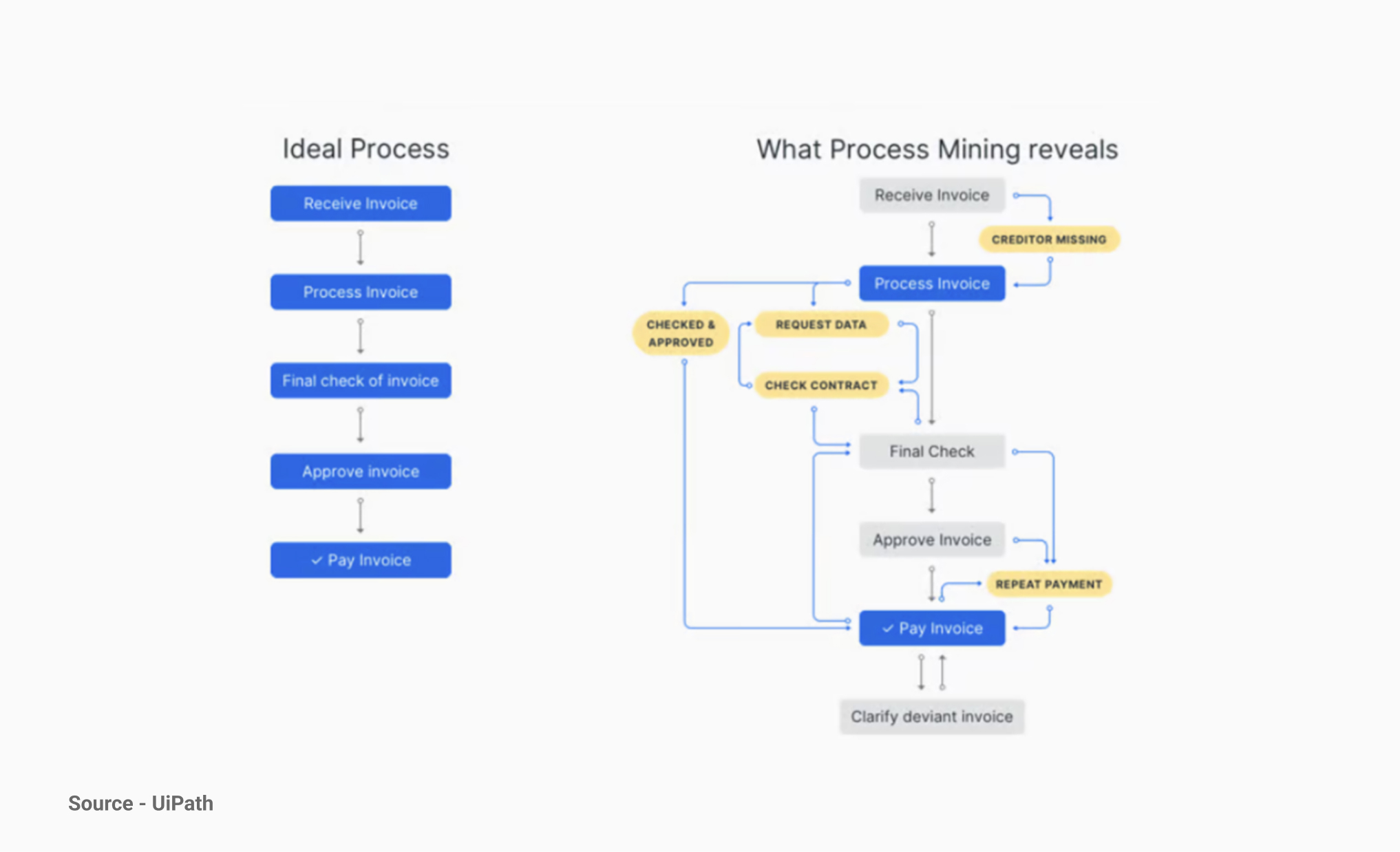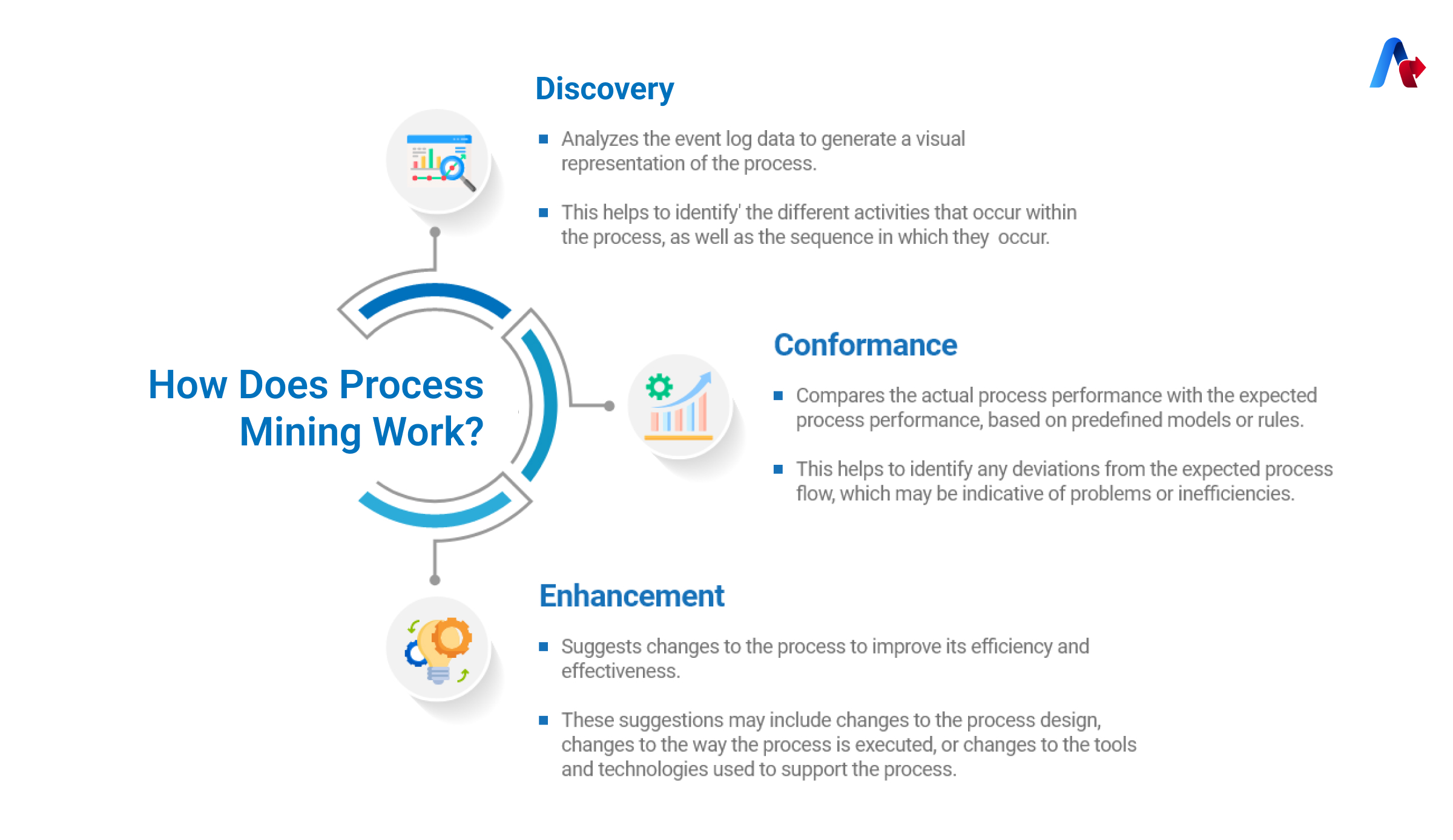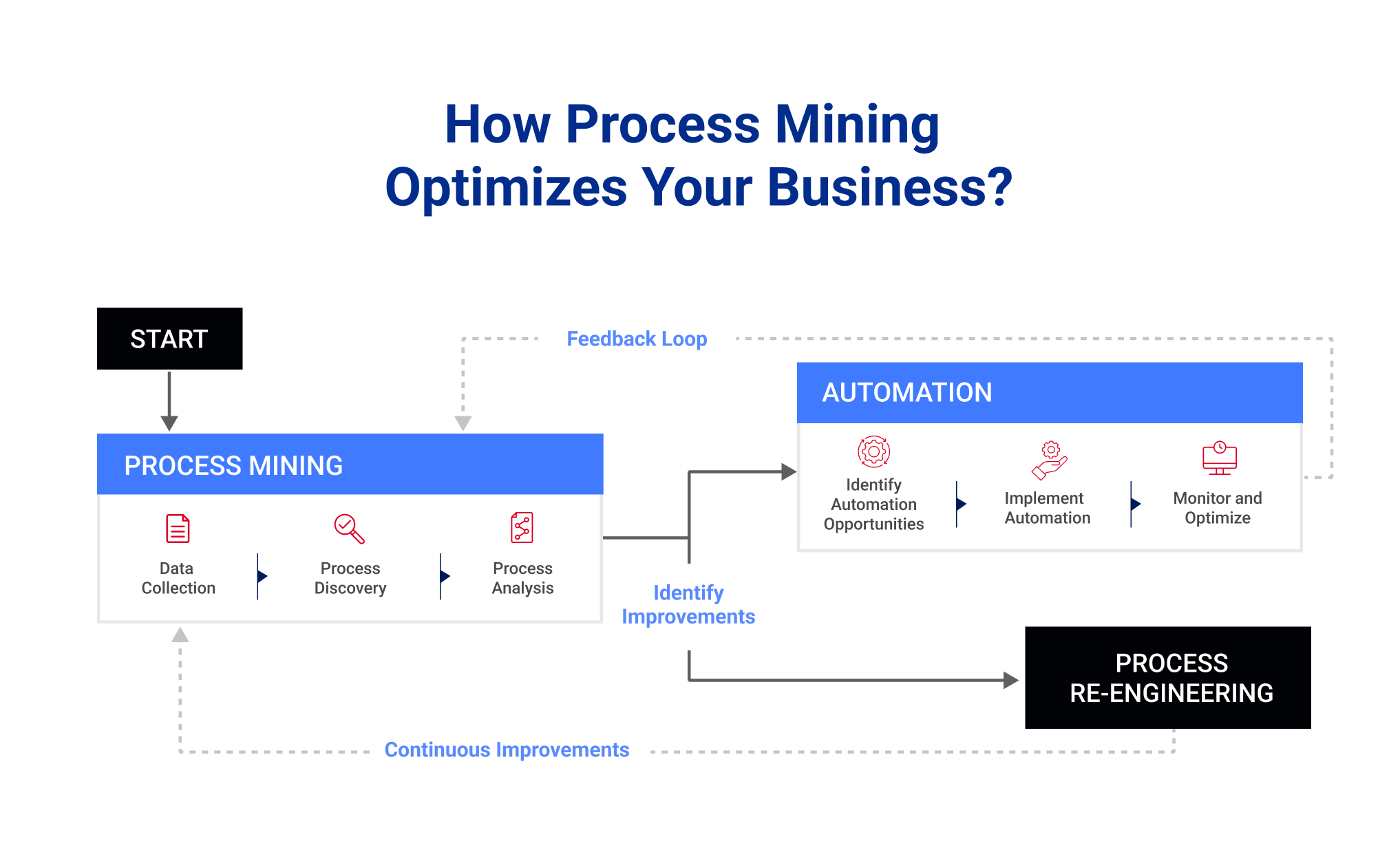Process Mining
BLOG
There is a lot that goes into business processes. Managing mountains of data, complex integrations, critical workflows, quick decision-making, strategic planning, and more. Amidst all this, a lot of valuable data and insights often get buried, making it difficult to spot where things are slowing down or going off track. As businesses strive to optimize operations, process mining emerges as a powerful asset. This innovative tool goes beyond traditional data analysis. It doesn’t just make sense of your massive data, but also transforms them into actionable insights that drive increased efficiency and automation. Process Mining acts as your roadmap to automation, helping you identify tasks for automation, streamline workflows, and eliminate repetitive, time-consuming processes.
By 2026, 25 percent of global enterprises will have embraced process mining platforms as a first step to creating a digital twin for business operations, paving the way to autonomous business operations - Gartner.
Ready to accelerate your digital transformation with smarter automation? Read on to know how!
What is Process Mining?
Process Mining is a method of data analysis that enables organizations to visualize their processes based on the digital footprints left by their operations. By utilizing algorithms and powerful software, Process Mining constructs a detailed visualization of how processes actually perform, uncovering variations and bottlenecks that can be optimized for better efficiency and productivity. This approach provides fact-based insights and clear visibility into how processes operate, significantly aiding companies in their decision-making process.
Traditionally, companies have invested heavily in data analysis to gain insights for better decision-making. While data analysis is effective for providing a general overview, it often falls short in detailing the intricate interaction of processes. This gap led to the evolution of Process Mining. It takes data analysis a step further by visually mapping out the workflow within an organization. By integrating data from system logs, Process Mining generates a visual process flow, offering a thorough, fact-based view of process performance.

How Does Process Mining Work?
Process mining is a powerful technique that uses data from your existing IT systems to create a detailed, end-to-end visualization of your business processes. By analyzing the digital footprints left behind as your processes are executed, business process mining can uncover hidden inefficiencies, bottlenecks, and opportunities for optimization.
3 Ways Process Mining Accelerates Digital Transformation
Process Mining works in THREE different phases Discovery, conformance, and enhancement. These three phases are critical for organizations to identify the correct and effective process. The first step is that the organization should change the approach for process discovery from traditional to process mining.
- Data Discovery: The first step is to analyze the event log data to generate a visual representation of the process. This helps to identify the different activities that occur within the process, as well as the sequence in which they occur.
- Conformance: Compares the actual process performance with the expected process performance, based on predefined models or rules. This helps to identify any deviations from the expected process flow, which may be indicative of problems or inefficiencies.
- Enhancement: Suggests changes to the process to improve its efficiency and effectiveness. These suggestions may include changes to the process design, changes to the way the process is executed, or changes to the tools and technologies used to support the process.

What are the Benefits of Process Mining?
Process Mining is not just about gaining better visibility into business processes, but also to help you run it smoothly. Let’s look at some of its significant benefits:
- Find Slowdowns: It helps you identify areas where things get stuck, like slow approvals or repetitive tasks. This lets you fix those slowdowns or even automate them for a faster pace.
- Better Decisions: No more guessing! Process mining gives you real facts to back up your decisions about improving processes. It's like having all the information you need to make smart choices.
- Ensure Compliance: Need to be on track with compliance? Process mining can help you ensure that your processes are adhering to regulatory requirements and internal policies, reducing the risk of non-compliance.
- Happy Customers: Faster processes mean happier customers! By identifying and fixing slowdowns, process mining helps you deliver a smooth experience.
- Ready for Automation: Thinking about using Robotic Process Automation (RPA) to automate tasks? Process mining gives you a clear understanding of how things work now, which is crucial for making automation successful.
- Drive Continuous Improvement: With the insights from process mining, you can continuously optimize your processes, driving greater efficiency, productivity, and cost savings.
- Accelerate Digital Transformation: Process mining is a key to a faster digital transformation, providing the data-driven insights you need to reimagine and streamline your business processes.
Related Read: Optimizing Efficiency: Process Mining for Organizational Transformation
Process Mining Use Cases Across Industries
Process mining has a wide range of applications across various industries and business functions. In fact, it has empowered businesses to make data-driven decisions and transform their processes for the better. Here are some real-world uses cases of process mining and its impact on businesses across different sectors:
1. Manufacturing: Streamlining Production Lines for Efficiency
Challenge: Manufacturing processes are often complex, with multiple steps and potential bottlenecks. Identifying these bottlenecks and optimizing material flow can be a challenge.
Solution: Process mining can analyze data from production machines, inventory systems, and other sources to pinpoint bottlenecks and delays. This allows manufacturers to optimize production scheduling, identify opportunities for automation, and ultimately reduce production time and costs.
2. Finance & Banking: Accelerating Loan Processing and Reducing Fraud
Challenge: Loan application processes can be lengthy and error-prone, leading to customer frustration and missed business opportunities. Additionally, fraud detection within financial transactions can be a complex task.
Solution: Process mining can analyze loan application data to identify inefficiencies and delays. This allows banks to streamline the application process, identify areas for automation, and ultimately improve customer satisfaction. Additionally, process mining can analyze transaction patterns to detect anomalies and identify potential fraudulent activity.
3. Healthcare: Optimizing Patient Care and Reducing Costs
Challenge: Healthcare processes are layered with a lot of steps involving patient intake, treatment, and billing. This can lead to delays in care and inefficiencies in resource allocation.
Solution: Process mining can analyze patient data from various sources, including electronic health records, appointment scheduling systems, and billing data. This allows hospitals and healthcare providers to identify bottlenecks in patient intake, optimize treatment protocols, and improve overall patient care. Additionally, process mining can be used to analyze billing data to identify potential errors and opportunities for cost reduction.
4. Supply Chain Management: Ensuring Transparency and Improving Logistics
Challenge: Supply chains involve multiple stakeholders which can lead to a lack of transparency, making it difficult to identify and address inefficiencies.
Solution: Process mining can analyze data from various sources in the supply chain, such as order tracking systems, inventory management software, and transportation logistics data. This allows businesses to gain a clear view of their supply chain, identify bottlenecks in product delivery, and optimize logistics processes for faster delivery times and reduced costs.
These are just a few examples of how processing mining is transforming various industries. Its potential and usability extend far beyond these use cases.
Looking for effective automation strategies?
Talk to Our Experts!Significance of Process Mining in Automation, Making Complexities Simpler
Process mining and automation converge in a reciprocal system that enhances overall business efficiency through a continuous feedback loop. Process mining employs robust and meticulous analysis to derive valuable insights from vast and intricate data, revealing hidden inefficiencies and bottlenecks. This revelation aids in identifying potential areas for improvement. Once these bottlenecks are identified, companies can ascertain where automation can be most effectively deployed. In essence, process mining maps the territory and automation builds the road. Let’s look at a case study for more clarity.
Case Study
An e-commerce enterprise dealing with a large volume of orders, customer inquiries, and returns. Manually managing such processes often results in errors and inefficiencies, impacting both customer satisfaction and the bottom line.
Employing process mining to these diverse and dense data points exposed a significant issue: a time-consuming and inefficient return approval process that was causing backlog and hindering overall operational performance.
Addressing these discrepancies, the company introduced an automated workflow for return approvals, drawing on insights delivered by process mining. Through scrutinous monitoring and fine-tuning, the automated mechanism drastically reduced the backlog, streamlined the return process, and significantly improved customer satisfaction. Resources previously tied up in this tedious process were now freed up for more value-added tasks.
In a nutshell, process mining and automation, working harmoniously, can illuminate bottleneck areas and provide effective, data-driven solutions for business process re-engineering.
Optimizing Business Operations with Process Mining and Process Re-engineering
Process mining is an invaluable asset in managing workflow and improving efficiency. Serving as a diagnostic tool, it assesses and quantifies processes, illustrating task flow and uncovering gaps or redundancies. This in-depth analysis allows a systemic understanding of workflow, task completion times, and overall productivity levels. With these insights, specific touchpoints needing improvement can be identified. This in-depth visualization offered by process mining fundamentally enhances the ability to manage workflow and improve efficiency.
However, the need for a more comprehensive review and redesign of processes may arise due to various factors. These can include an ongoing slowdown due to bottlenecks, a significant gap between current performance and desired efficiency levels, or a drastic change in the business environment. In such scenarios, process mining takes on an even more critical role. It serves as a precise guide during the re-engineering process, providing fact-based insights, and helping businesses identify the processes that will benefit from a comprehensive redesign.
Basically, process mining paves the way for improved performance, fostering a culture of continuous improvement and innovation.

Embracing the Digital Transformation with Process Mining
Implementing process mining is all about adaptation, a readiness to embrace change and transform the future of your enterprise. This requires stakeholders to be engaged, educated about its benefits, and trained to handle its application effectively. Moreover, it needs a shift in the perception of data – from being an overwhelming challenge to a priceless resource.
As we move forward digitally, companies that successfully implement process mining will have a major advantage. They'll be able to act on detailed insights drawn from their business processes, streamline operations more efficiently, and, ultimately, gain a competitive edge in their industry.
Let's Drive Your Business Towards a Profitable ROI with Automation!
Looking at the remarkable contribution of Process Mining to business operations, its significance both now and in the future is undeniable. It meticulously decodes the complexities of your operations, identifying areas where automation can make a difference and where processes need a redesign. From enhancing efficiency to influencing smart decision-making, Process Mining can be the cornerstone of a successful digital transformation.
Adopting this innovative tool means optimized workflows and seamless business processes. Along with that, with process mining solutions, you are empowering your team to develop strategies that drive your organization towards a profitable ROI with automation. Partnering with a trusted industry expert like Accelirate can guide you through this process and leverage its full potential.


